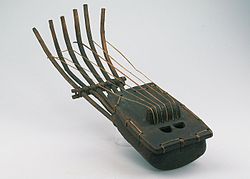You can help expand this article with text translated from the corresponding article in German. (October 2019) Click [show] for important translation instructions.
|
The pluriarc, also called paata, mapu, luku,[1] kissanga, and bow lute[2] is a stringed musical instrument of West Africa, classified as a type of lute. It has a hollow body and several curved, pliable necks made of reeds. The strings stretch from the necks to the bridge, which stands approximately 1.5 inches (38 mm) above the body.[1] The body may be round, rectangular, or triangular, and is usually made of light wood.[3] The top of the body can either be a separate board, bound or nailed to the lower part, or made from the same piece of wood as the rest. A hole may exist on the underside that can be opened or closed to change the timbre.[4]
 | |
| Other names | bow lute, paata, mapu, luku, kissanga |
|---|---|
| Classification | |
| Hornbostel–Sachs classification | 321.1 (Bow lute) |
| Related instruments | |
| Harp, Lute, Musical bow, Masenqo, Gusle, Igil, Krar | |
It is played by plucking the strings, which are usually open but sometimes contain a stop. The strings may be plucked with fingers or a plectrum.[2] The flexible nature of the necks means the instrument cannot be tuned precisely.[3]
Pluriarc designs have been characterized into three types by country of origin: those of southwestern Africa, central west Africa, and western Nigeria.[1]
References edit
- ^ a b c "pluriarc · Grinnell College Musical Instrument Collection". omeka1.grinnell.edu. Retrieved 2019-10-15.
- ^ a b "Pluriarc | musical instrument". Encyclopedia Britannica. Retrieved 2019-10-15.
- ^ a b Blench, Roger (31 July 2009). "A guide to the musical instruments of Cameroun: classification, distribution, history and vernacular names" (PDF). Kay Williamson Educational Foundation. Retrieved 2019-10-16.
- ^ "Longombe". music.africamuseum.be. Retrieved 2019-10-16.
External links edit
- Media related to Bow lutes at Wikimedia Commons